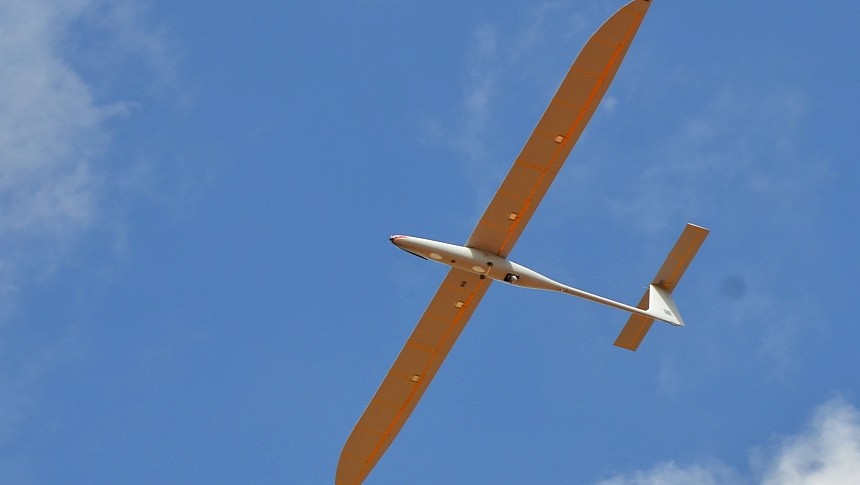At first glance, the K1000 UAV (uncrewed aerial vehicle) looks deceptively simple. Yet, it claims enough power to replace conventional satellites someday altogether. Developed by a Californian startup, this innovative aerial platform set a new endurance record during a recent Oregon flight.
Last year, the Stalker VXE developed by Lockheed Martin dazzled the world with a non-stop flight of 36h 17m. It officially set a new endurance record for uncrewed aircraft in the Group 2 fixed-wing category. According to Pentagon's classification system, this category includes all automated flying machines from 9.5 to 25 kg (21-55 lbs).
However, that victory didn't last more than a year. Kraus Hamdani Aerospace (KHA), a relatively new kid on the block, recently took over the crown thanks to a record-breaking flight. It happened earlier this month when KHA’s solar-electric UAV completed a 75h and 35m flight. It was significantly longer than the Stalker VXE's previous record. Most importantly, it ditched conventional fuel entirely.
The KHA UAV, officially named the K1000ULE (Ultra-Long Endurance), showed what it could do at Oregon's Pendleton UAS test range. By staying in the air for more than 75 hours, it officially set a new world record for the Group 2 category. Coincidently, it was also the aircraft's 75th flight.
The K1000 also broke its own record. Last year, it was reported that the new UAV claimed a 26-hour flight endurance and a 20,000-foot (6,096 meters) operational ceiling.
The K1000's technology was directly inspired by birds capable of flying long distances. It combines autopilot capabilities with battery systems and onboard AI. It was specifically designed to stay in the air as much as possible and to reach as far as possible without relying on fuel.
This isn't about fewer emissions but mostly about self-sufficiency. A solar-electric UAV isn't tied to infrastructure, meaning it can operate more effectively at significantly lower costs. Due to these advantages, the Californian startup believes that one day UAVs such as the K1000 could become a better alternative to satellites.
These aircraft are known as pseudo-satellites with impressive surveillance and signal re-transmission capabilities. The K1000 was specifically designed for military applications, with a focus on highly-contested and GPS-denied environments. At the same time, it has great potential for civilian applications, from disaster relief and search-and-rescue missions to climate change research.
Solar flying machines are becoming increasingly important for both army and commercial applications. Airbus developed a similar platform called Zephyr. Officially a High Altitude Platform Station (HAPS), Zephyr is a solar-electric UAS (unmanned aerial system) that also acts as a pseudo-satellite.
Back in 2018, it broke the endurance record by flying for 25 days, 23 hours, and 57 minutes without any stops. Last summer, it set a new record for the longest non-stop flight of an uncrewed aircraft, landing after 64 days, 18 hours, and 26 minutes.
However, that victory didn't last more than a year. Kraus Hamdani Aerospace (KHA), a relatively new kid on the block, recently took over the crown thanks to a record-breaking flight. It happened earlier this month when KHA’s solar-electric UAV completed a 75h and 35m flight. It was significantly longer than the Stalker VXE's previous record. Most importantly, it ditched conventional fuel entirely.
The KHA UAV, officially named the K1000ULE (Ultra-Long Endurance), showed what it could do at Oregon's Pendleton UAS test range. By staying in the air for more than 75 hours, it officially set a new world record for the Group 2 category. Coincidently, it was also the aircraft's 75th flight.
The K1000 also broke its own record. Last year, it was reported that the new UAV claimed a 26-hour flight endurance and a 20,000-foot (6,096 meters) operational ceiling.
The K1000's technology was directly inspired by birds capable of flying long distances. It combines autopilot capabilities with battery systems and onboard AI. It was specifically designed to stay in the air as much as possible and to reach as far as possible without relying on fuel.
This isn't about fewer emissions but mostly about self-sufficiency. A solar-electric UAV isn't tied to infrastructure, meaning it can operate more effectively at significantly lower costs. Due to these advantages, the Californian startup believes that one day UAVs such as the K1000 could become a better alternative to satellites.
These aircraft are known as pseudo-satellites with impressive surveillance and signal re-transmission capabilities. The K1000 was specifically designed for military applications, with a focus on highly-contested and GPS-denied environments. At the same time, it has great potential for civilian applications, from disaster relief and search-and-rescue missions to climate change research.
Solar flying machines are becoming increasingly important for both army and commercial applications. Airbus developed a similar platform called Zephyr. Officially a High Altitude Platform Station (HAPS), Zephyr is a solar-electric UAS (unmanned aerial system) that also acts as a pseudo-satellite.
Back in 2018, it broke the endurance record by flying for 25 days, 23 hours, and 57 minutes without any stops. Last summer, it set a new record for the longest non-stop flight of an uncrewed aircraft, landing after 64 days, 18 hours, and 26 minutes.







